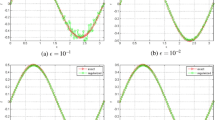Abstract
This article is concerned with the identification, from observations or field measurements, of the hydraulic conductivity for the saltwater intrusion problem in an unconfined aquifer. The involved model consists in a cross-diffusion system describing the evolutions of two interfaces: one between freshwater and saltwater and the other one between the saturated and unsaturated zones of the aquifer. The inverse problem is formulated as an optimization problem, where the cost function is a least square functional measuring the discrepancy between experimental interfaces depths and those provided by the model. Considering the exact problem as a constraint for the optimization problem and introducing the Lagrangian associated with the cost function, we prove that the optimality system has at least one solution. Moreover, we establish the first-order necessary optimality conditions. A numerical method is implemented to solve this identification problem. Some numerical results are presented to illustrate the ability of the method to determine the unknown parameters.












Similar content being viewed by others
References
Ranjan, P., Kazama, S., Sawamoto M.: Modeling of the dynamics of saltwater–freshwater interface in coastal aquifers. In: Proceedings of the Joint AOGS Annual Meeting and APHW Second Conference, Singapore, pp. 373–380 (2004)
Carrera, J.: State of the art of the inverse problem applied to the flow and solute transport problems. In: Groundwater Flow Quality Modelling. NATO ASI Series C, pp. 549–589. Kluwer Acad., Norwell (1998)
Ginn, T.R., Gushman, J.H.: Inverse methods for subsurface flow: a critical review of stochastic techniques. Stoch. Hydrol. Hydraul. 4, 1–26 (1990)
Kuiper, L.: A comparison of several methods for the solution of the inverse problem in two-dimensional steady state groundwater flow modeling. Water Resour. Res. 22(5), 705–714 (1986)
McLaughlin, D., Towenley, L.R.: A reassessment of the groundwater inverse problem. Water Resour. Res. 32(5), 1131–1161 (1996)
Sun, N.Z., Yeh, W.G.: Coupled inverse problems in groundwater modelling 1. Sensitivity analysis and parameter identification. Water Resour. Res. 26, 2507–2525 (1990)
Yeh, W.W.G.: Review of parameter identification procedures in groundwater hydrology: the inverse problem. Water Resour. Rev. 2, 95–108 (1986)
Tber, M.H., Talibi, M.E., Ouazar, D.: Identification of the hydraulic conductivities in a saltwater intrusion problem. J. Inv. Ill-Posed Probl. 15(9), 935–954 (2007)
Tber, M.H., Talibi, M.E., Ouazar, D.: Parameters identification in a seawater intrusion model using adjoint sensitive method. Math. Comput. Simul. 77(2–3), 301–312 (2008)
Meyers, N.G.: An Lp-estimate for the gradient of solution of second order elliptic divergence equations. Ann. Sc. Norm. Sup. Pisa 17, 189–206 (1963)
Jazar, M., Monneau, R.: Derivation of seawater intrusion models by formal asymptotics. SIAM J. Appl. Math. 74(4), 1152–1173 (2014)
Choquet, C., Diédhiou, M.M., Rosier, C.: Mathematical analysis of a sharp–diffuse interfaces model for seawater intrusion. J. Differ. Equ. 259(8), 3803–3824 (2015)
Alkhayal, J., Issa, S., Jazar, M., Monneau, R.: Existence results for degenerate cross-diffusion systems with application to seawater intrusion. ESAIM Control Optim. Calc. Var. 24(4), 1735–1758 (2018)
Choquet, C., Li, J., Rosier, C.: Uniqueness for a cross-diffusion system issuing from seawater intrusion problems. EJDE No. 256, pp. 1–22 (2017)
Evans, L.C.: Partial Differential Equations, vol. 19. American Mathematical Society, Providence (1998)
Sun, N.Z.: Inverse Problems in Groundwater Modelling. Kluwer Academic Publishers, Dordrecht (1994)
Benson, S.J., Moré, J.: A limited memory variable-metric algorithm for bound-constrained minimization. Technical report ANL/MSC-P909-O901, Mathematics and Computer Science Division, Argonne National Laboratory (2001)
Byrd, R.H., Lu, P., Nocedal, J., Zhu, C.: A limited memory algorithm for bound constrained optimization. SIAM J. Sci. Stat. Comput. 16(5), 1190–1208 (1995)
Bear, J.: Dynamics of Fluids in Porous Media. Elsevier, New York (1972)
Keidser, A., Rosbjerg, D.: A comparison of four inverse approaches to groundwater flow and transport parameter identification. Water Resour. Res. 27(9), 22, 19-32 (1991)
Franssen, H.J.H., Alcolea, A., Riva, M., Bakr, M., van der Wiel, N., Stauffer, F., Guadagnini, A.: A comparison of seven methods for the inverse modeling of groundwater flow. Application to the characterization of well catchments. Adv. Water Resour. 32(6), 851–872 (2009)
Author information
Authors and Affiliations
Corresponding author
Additional information
Publisher's Note
Springer Nature remains neutral with regard to jurisdictional claims in published maps and institutional affiliations.
Rights and permissions
About this article
Cite this article
Mourad, A., Rosier, C. A Nonlinear Optimization Method Applied to the Hydraulic Conductivity Identification in Unconfined Aquifers. J Optim Theory Appl 183, 705–730 (2019). https://doi.org/10.1007/s10957-019-01571-2
Received:
Accepted:
Published:
Issue Date:
DOI: https://doi.org/10.1007/s10957-019-01571-2
Keywords
- Parameters identification
- Optimization problem
- Cross-diffusion system
- Fixed point theorem
- BLMVM algorithm




